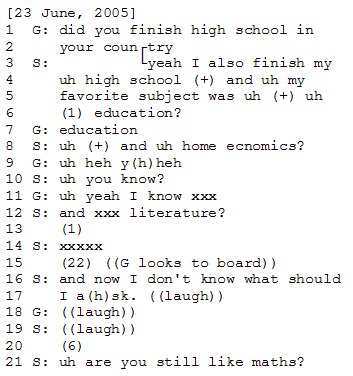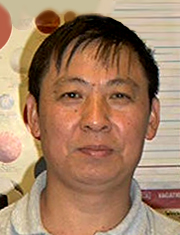Guangli attended school for 15 years in China finishing high school and a three-year economics college. Since moving to the U.S. in January, 2003 he has been unemployed and hoped to devote his time in learning English especially improving his English communication skills. He attended ESL classes at Portland Community College for ten terms (from April 2003 to August 2005). While he reported in 2003 that he had no goals in terms of education, in 2004 and 2005 he reported hoping to attend vocational, trade or business school.
After several years of formal study of English in the U.S., Guangli's interactions in the classroom show him to be somewhat reserved, soft spoken, perhaps shy. When asked in an interview in 2005 what were four classroom activities that he liked most (out of a possible list of 12 typical classroom participation structures and activities), Guangli mentioned some of the more passive activities out of the 12 as his favorites: 1) teacher lecture, 2) grammar, 3) pronunciation, 4) listening to others speak.
There is evidence in his classroom interactions with peers that he was a student who was able or wanted to take the lead in conversational interaction. In the following excerpt from the first week of Guangli's tenth term of ESL, students' task is to use two questions to start a conversation of about 10 minutes. The teacher explained that she did not want students to just ask the two questions ("did you finish high school"? and "what were your favorite subjects in high school"?) but to have a conversation using those questions as ways to start.
After the teacher gave the students the instructions for the task, Guangli's deskmate asks him the two questions. Guangli reports that he did finish high school and that math and physics were his favorite subjects. He then asks S about whether she finished high school.(Click to View) (Requires Internet Explorer)

After S answered Guangli's questions, there was a long pause (line 15) before S wonders aloud what the next step should be to develop a conversation (lines 16-17).
Such reticence in classroom conversational interaction conflicts with Guangli's rather sophisticated understanding of language learning that he disclosed in an interview from nine months after that particular classroom interaction (March 2006). Here, he talks about language learning being effective when it is situated.
| Guangli: | One day, I talked to an American about leeks, how to say it in English. I said in English- "chew", the wrong pronunciation. The American said "que". Then, I did not forget the pronunciation of the word. It is just like that to learn language. When you say something wrong and someone corrects your mistake, then you memorize it deeply and won't forget it. When you learn it by yourself, you cannot learn much. Also, when you learn English through work, you learn English through a purpose. It is easier to memorize. | |
| I: | It can help to internalize. | |
| Guangli: | Yes | |
| Hide Conversation | ||
Such an understanding of language learning is similar to a community of practice theory of learning (Lave & Wenger, 1991) where learning is seen as a change from legitimate peripheral participation to full participation in mentoring or work situations.
Later in the interview, when asked about his biggest challenge since coming to the U.S, Guangli mentions ‘language' as the biggest challenge and goes on to describe a a reflexive process of language socialization - social interaction both facilitating and occurring because of language.
| I: | So, you came here as an immigrant three years ago. What do you think has been your biggest challenge or difficulty? | |
| Guangli: | The biggest difficulty is language. It is because language relies on our being acknowledged in society. As humans, we have interactions. Through interaction, people can communicate so that you can learn some language. News can give us some hints. If you do not have language, there is no way; so if you do not have good language, you cannot live in society. If you cannot live in society, you will not know what is going on in society. If you do not know what is going on in society, then you will not know the living conditions. Your judgments can help you, however, you still cannot be completely acculturated. | |
| Hide Conversation | ||
It seems that while Guangli understands the importance of social interaction for language learning (in March 2006), observations of his classroom interaction suggest that engaging in conversational interaction with classmates was not easy for him.
